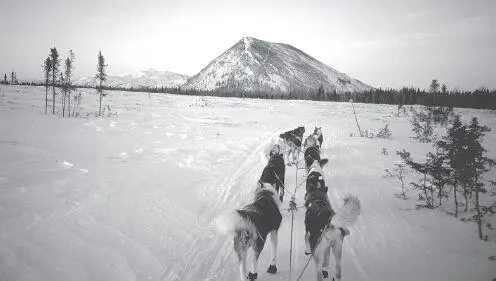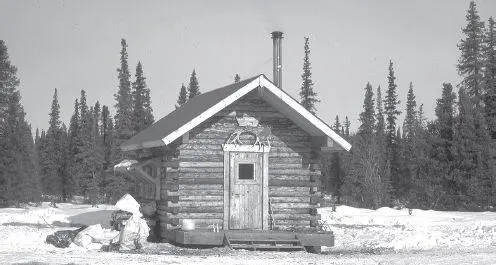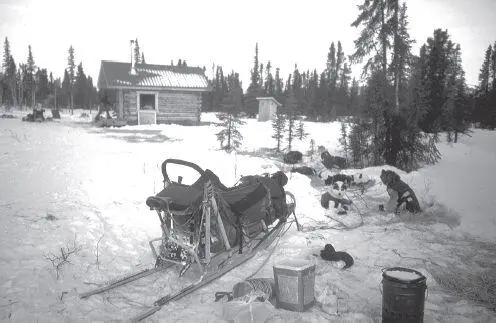Flying for the race I’ve been caught numerous times by fast-moving fronts in this area. In 1991 I flew over Kazuo Kojima barely 10 miles east of Unalakleet as he was making good time across the tundra in the warm afternoon sunshine. Within an hour a major storm roared in from the southwest and Kazuo didn’t stagger into the checkpoint for six uncertain hours, having been all but trapped by high winds and heavy drifting snow virtually within sight of town.
And during that hour’s lull before the storm I flew up to Shaktoolik to pick up some dropped dogs and very nearly flipped my airplane in unexpected winds gusting to 70 knots. The storm lasted for three days and temporarily shut down the race. In short, I — and a lot of other people — don’t trust the weather out here any farther than we can see it, and even then we’re not always sure.
That’s why there are shelter cabins scattered along most of the winter trails in this part of the state. Some are like the one at Tripod Flats: a snug log cabin set in a wooded swale, built and maintained by the town of Kaltag and the Bureau of Land Management, with a good stove and bunks and stocked with firewood. Others are plywood shacks belonging to local fishermen or hunters standing austerely on bleak shorelines or expanses of tundra. But they all provide refuge to whomever needs it in this land where an hour’s jaunt on a snowmachine or dog team can turn into a week-long survival exercise.
When I finally pull up to the Tripod Flats cabin Lisa’s team is stopped in front of it. As much as we’d like to stay here a few hours we decide it’s best to push on before dark to the Old Woman cabin, 15 miles ahead. Then we’ll be only 40 miles from Unalakleet and in a better position to check out any changes in the weather.
The snow flurries continue to come and go. I still don’t see anything serious — but then, I didn’t see anything coming back in 1991, either. We move smoothly down to Old Woman, marked by its namesake flat-topped hill jutting immediately behind it. Andy is there when we pull in just after sunset; he says he’s been there for a couple of hours, which just shows how fast his speed merchants are. He decides to wait a while and then move on with us just in case the weather turns bad.
Like almost all shelter cabins this one has a wood stove. While our cookers are steaming next to the sleds making hot water for dog food we decide to get a fire going in the stove to warm up the cabin. Lisa rummages around in her sled bag and produces three artificial fire logs; she says she’s shipped them out to most checkpoints and carries them in case she needs to camp out. I can’t argue with her logic as the logs start instantly and make a cheerful fire. Besides, I learned years ago to carry a 20-pound bag of easy-lighting charcoal in my plane for exactly the same purpose.

Old Woman cabin is just in front of its distinctive flat-topped namesake mountain. The hill is a prominent landmark on the long run from Kaltag to Unalakleet.
We tend to the dogs for awhile as their food soaks. After a few minutes we become aware of a strange glow dancing in the treetops, much like firelight. Since we’re done with the cookers, I look around for the source. To my chagrin I see bright orange flames shooting two feet out of the chimney of the cabin. Waves of heat are radiating from the cabin’s roof and sides. We run inside and find the stove starting to glow cherry red.
The fire logs are burning hotter than a meltdown in a nuclear plant and my overriding thought is we’re going to be responsible for torching the Old Woman cabin. We don’t have any water to throw on the logs so all we can do is shut the damper and hope for the best. As we wait anxiously for the inferno to simmer down I look at the discarded label from one of the logs. One warning says never to use more than one at a time, another says don’t stack any wood on top of the one on fire, and a third cautions never to use these in a wood stove. We’ve managed to flaunt all three simultaneously and the result has been spectacular. The folks at Underwriters’ Lab will use us as their poster kids for the next decade.
After several minutes the blast furnace returns to merely volcanic levels and we retreat outside to escape the sauna we’ve created. I’m certain there’s an inch less snow out here than before we lit the stove, and the dogs seem to be panting like they’ve just run all day in the sun. I hope it’s just my imagination as I start to feed.
Working down the line with the dog food, I remember an experience Aaron Burmeister told me he had here in 1994 on his rookie run. He had eight dogs in Kaltag but dropped one before moving on to Unalakleet. At Old Woman, he stopped to feed, and put out eight bowls of food without thinking. When he looked around, he saw eight dogs eating. The eighth dog was a wolf. It finished its food and vanished instantly into the trees, leaving Aaron to wonder exactly what was going on.

The new Bureau of Land Management shelter cabin at Old Woman, 50 miles west of Kaltag on the trail to Unalakleet, replaces an older plywood shack a mile away. It is one of two similar BLM cabins on the 90-mile Kaltag Portage. Like many such refuges along Alaska’s trails, it offers a secure haven to any traveler who needs it.
I have a wolf eating with my team as well, but Silvertip has been with us since we left Fourth Avenue and is doing quite well for an accidental sled dog. I wonder what he thinks about our trip so far, and whether he can sense his cousins lurking in the shadows.
Some of the old-timers ran wolves and wolf hybrids, raising them from puppies or breeding them with huskies. In 1932 and 1933 Slim Williams ran a team of wolf hybrids from Alaska to Chicago for the World’s Fair to promote what would ultimately become the Alaska Highway. It was quite a sensation at the time, but wolves haven’t been much in vogue as sled dogs since then.
We nap for an hour or so in the almost charred cabin. Before we depart we are careful to leave some food for ghost of the old woman, as is the tradition; she is said to watch over those who remember her. We make sure we set her a proper feast: we almost incinerated her house tonight and we certainly don’t need her mad at us — it’s still a long way to Nome. We’ve already chased enough ghosts and we don’t need any chasing us at this point.
As usual Andy pulls out a half hour ahead of Lisa and me. It’s snowing as we follow the trail up onto the open tundra paralleling the south side of the river. Despite the stereotypical scenes of treeless ice and barren tundra most people associate with the Bering Sea coast, there are actually quite a few trees out here. Most of the larger rivers have substantial green belts and the Unalakleet River which flows down the western part of the Kaltag Portage is no exception.

Some of the checkpoints on the Iditarod can be almost 100 miles apart. At some point on these marathons, mushers must “camp out” for several hours to feed and rest the dogs. In a few instances, conveniently located shelter cabins are popular camping locations, such as the Old Woman Cabin.
The trail from Old Woman to Unalakleet stays mostly just up out of the tree line, on the tundra a few miles south of the river. While this is a more direct route, it is much more exposed and is especially vulnerable to any snowfall and accompanying drifting. Over the years hundreds of permanent reflectors have been put up to mark the trail through this section, nailed to any convenient bush or tree. Where there are no trees there are crude wooden tripods.
Читать дальше















